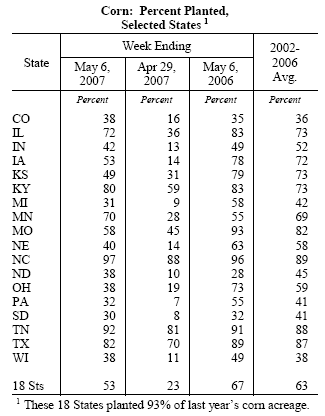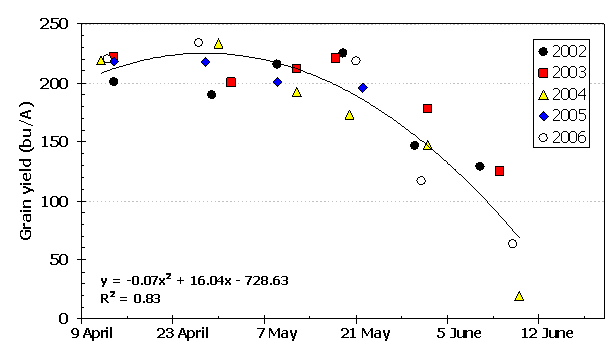Planting Progress and Scouting Early-Season Corn
May 10, 2007
Joe Lauer, Corn Agronomist
Early May has provided many days for field work. Planting progress in Wisconsin
was 38% complete on May 6 (Table 1). More progress than normal has been made in
northern Wisconsin due to dry weather. The western side of Wisconsin has also seen
good progress. Southeastern Wisconsin has been wet and progress has been slow.
Table 1. Crop planting progress in Wisconsin.

To date, Wisconsin has planted about the same number of acres as the previous 5
years (Table 2). States which are more than 10% behind their 5-yr average include
Iowa, Kansas, Michigan, Missouri, Nebraska, Ohio, and South Dakota. Overall progress
is slightly behind, but nothing to be concerned about yet.
Table 2. Corn planting progress in the US (source USDA, NASS).

One of the most important management decisions in corn production is planting date.
In Wisconsin, grain yield is reduced about 30% between May 1 and June 1 (Figure
1). In addition to grain yield reductions, grain moisture at harvest is greater
increasing drying costs and reducing profitability. Greater risk (variability) is
measured as planting date is delayed for both grain yield and profit..
May 1 is the date when maximum yield is typically measured for corn in southern
Wisconsin (May 5 in northern Wisconsin ). The planting window for full-season hybrids,
where yield is within 95% of the date of maximum yield, is 10 days before and after
May 1 in southern Wisconsin (April 20 and May 10). In northern Wisconsin, planting
window is much shorter at about 5 days before and after the date of maximum yield
(May 5).

Figure 1. Response of a "full-season" corn hybrid to planting date at Arlington,
WI.
Planting date decisions and Switching hybrid maturities
Full-season hybrid maturities provide the greatest yield potential in corn. So begin
planting using full-season hybrids. But, beginning about May 10, farmers need to
begin considering switching to shorter-season hybrid maturities. This year may be
difficult to switch hybrid maturity due to seed availability of shorter-season hybrids.
From a practical standpoint, hybrid maturity is typically switched once during the
season, unless farmers plan ahead and purchase a few hybrid maturities,
Switches need to begin first in northern WI and move south for any particular use
of grain. For dry corn, switch dates are earlier than for high moisture corn which
is earlier than for silage. By May 20, most corn should be switched to earlier maturities
(~7 d earlier). By June 1 another maturity switch might occur in southern Wisconsin.
After June 1 corn should not be planted in northern Wisconsin. The last date to
plant corn in southern Wisconsin is June 10.
Scouting early season corn
Begin scouting corn after you can see rows. As you walk your fields during early
corn emergence look for the following:
- Look for corn seed. Was there an operator, planter or some other mechanical error
that caused seed not to be planted.
- What is the planting depth? Shallower planted corn (less than 1 inch) may emerge
later due to drier soil surfaces and greater temperature fluctuations.
- Did the seed germinate? Cold wet conditions are the primary causes of seed death
during imbibition.
- Did the seed rot? Seed fungicides protect the seed and seedlings for about 30-40
days after planting, but can be overwhelmed by the pathogen if prolonged soil conditions
are cool and wet.
- Are insects feeding? Seedcorn maggot and wireworm are insects usually associated
with corn emergence failures.
- Make sure "Root tips are pointed down and shoots are pointed up."
Evaluating stand
For guidelines on evaluating corn stands click
here.
There are six steps in evaluating corn stands
- Determine plant population.
- Evaluate plant helath
- Assess the uneveness of the stand
- Compare the yield potential of a reduced stand to that of a replanted stand.
- Calculate replanting costs
- Factor in risks of replanting
If planting is delayed past the time acceptable corn production can be expected,
consider planting an alternative crop. Compare the relative yield potential and
current price of an alternative crop for a given date with that of late-planted
corn.